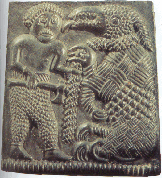Missing Sun myth: Difference between revisions
Appearance
Content deleted Content added
Kelly Martin (talk | contribs) revert back to version showing vfd header -- this article is listed on VfD and must remain with vfd header listed until vfd is closed |
Gabrielsimon (talk | contribs) revert to al |
||
| Line 1: | Line 1: | ||
{{vfd}} |
|||
The '''Missing Sun myth''' is a motif that appears in many [[myth]]s from around the world. The myth was probably used to explain any of several natural phenomena, including the disappearance of the [[sun]] at night, the shorter days during the winter, or even solar [[eclipse]]s. Most incarnations of the myth involve the disappearance of a [[Solar Deity]], through [[imprisonment]], [[exile]] or [[death]]. |
The '''Missing Sun myth''' is a motif that appears in many [[myth]]s from around the world. The myth was probably used to explain any of several natural phenomena, including the disappearance of the [[sun]] at night, the shorter days during the winter, or even solar [[eclipse]]s. Most incarnations of the myth involve the disappearance of a [[Solar Deity]], through [[imprisonment]], [[exile]] or [[death]]. |
||
Revision as of 05:00, 17 July 2005
The Missing Sun myth is a motif that appears in many myths from around the world. The myth was probably used to explain any of several natural phenomena, including the disappearance of the sun at night, the shorter days during the winter, or even solar eclipses. Most incarnations of the myth involve the disappearance of a Solar Deity, through imprisonment, exile or death.
Examples of Missing Sun myths

- In Egyptian mythology, Ra passes through Duat (the Underworld) every night. Apep has to be defeated in the darkness hours for Ra and his Solar Barge to emerge in the east each morning.

- In Japanese mythology, the Sun Goddess Amaterasu is angered by the behavior of her brother, Susanoo, and hides herself in a cave, plunging the world into darkness.

- In Norse mythology, both the gods Odin and Tyr have attributes of a sky father, and they are doomed to be devoured by wolves (Fenrir and Garm, respectively) at Ragnarok. Sol, the Norse Sun Goddess, will be devoured by the wolf Skoll.
